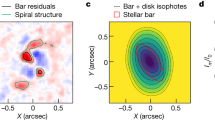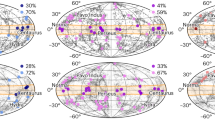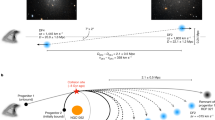Abstract
Bars are elongated structures that extend from the centre of galaxies, and about one-third of disk galaxies are known to possess bars1,2,3. These bars are thought to form either through a physical process inherent in galaxies4,5,6, or through an external process such as galaxy–galaxy interactions7,8,9. However, there are other plausible mechanisms of bar formation that still need to be observationally tested. Here we present the observational evidence that bars can form via cluster–cluster interaction10. We examined 105 galaxy clusters at redshift 0.015 < z < 0.060 that are selected from the Sloan Digital Sky Survey data, and identified 16 interacting clusters. We find that the barred disk-dominated galaxy fraction is about 1.5 times higher in interacting clusters than in clusters with no clear signs of ongoing interaction (42% versus 27%). Our result indicates that bars can form through a large-scale violent phenomenon, and cluster–cluster interaction should be considered an important mechanism of bar formation.
This is a preview of subscription content, access via your institution
Access options
Access Nature and 54 other Nature Portfolio journals
Get Nature+, our best-value online-access subscription
$29.99 / 30 days
cancel any time
Subscribe to this journal
Receive 12 digital issues and online access to articles
$119.00 per year
only $9.92 per issue
Buy this article
- Purchase on Springer Link
- Instant access to full article PDF
Prices may be subject to local taxes which are calculated during checkout


Sloan Digital Sky Survey (SDSS)

Similar content being viewed by others
Data availability
The data used in this work can be downloaded from the public data archive of SDSS (http://skyserver.sdss.org) and MPA-JHU catalogue at the website of https://www.sdss.org/dr14/spectro/galaxy_mpajhu/. The other data used for the plots within this paper are available from the corresponding author on reasonable request.
References
Jogee, S. et al. Bar evolution over the last 8 billion years: a constant fraction of strong bars in the GEMS survey. Astrophys. J. Lett. 615, 105–108 (2004).
Marinova, I. et al. Barred galaxies in the Abell 901/2 supercluster with stages. Astrophys. J. 698, 1639–1658 (2009).
Lee, G.-H., Park, C., Lee, M. G. & Choi, Y.-Y. Dependence of barred galaxy fraction on galaxy properties and environment. Astrophys. J. 745, 125 (2012).
Athanassoula, E. & Sellwood, J. A. Bi-symmetric instabilities of the Kuz’min/Toomre disc. Mon. Not. R. Astron. Soc. 221, 213–232 (1986).
Kwak, S., Kim, W.-T., Rey, S.-C. & Kim, S. Origin of non-axisymmetric features of Virgo cluster early-type dwarf galaxies. I. Bar formation and recurrent buckling. Astrophys. J. 839, 24 (2017).
Zana, T. et al. External versus internal triggers of bar formation in cosmological zoom-in simulations. Mon. Not. R. Astron. Soc. 473, 2608–2621 (2018).
Miwa, T. & Noguchi, M. Dynamical properties of tidally induced galactic bars. Astrophys. J. 499, 149–166 (1998).
Berentzen, I., Athanassoula, E., Heller, C. H. & Fricke, K. J. The regeneration of stellar bars by tidal interactions: numerical simulations of fly-by encounters. Mon. Not. R. Astron. Soc. 347, 220–236 (2004).
Łokas, E. L. et al. Adventures of a tidally induced bar. Mon. Not. R. Astron. Soc. 445, 1339–1350 (2014).
Bekki, K. Group-cluster merging and the formation of starburst galaxies. Astrophys. J. Lett. 510, 15–19 (1999).
Barazza, F. D. et al. Frequency and properties of bars in cluster and field galaxies at intermediate redshifts. Astron. Astrophys. 497, 713–728 (2009).
Aguerri, J. A. L., Méndez-Abreu, J. & Corsini, E. M. The population of barred galaxies in the local universe. I. Detection and characterisation of bars. Astron. Astrophys. 495, 491–504 (2009).
Shen, J. & Sellwood, J. A. The destruction of bars by central mass concentrations. Astrophys. J. 604, 614–631 (2004).
Athanassoula, E., Lambert, J. C. & Dehnen, W. Can bars be destroyed by a central mass concentration? I. Simulations. Mon. Not. R. Astron. Soc. 363, 496–508 (2005).
Bournaud, F., Combes, F. & Semelin, B. The lifetime of galactic bars: central mass concentrations and gravity torques. Mon. Not. R. Astron. Soc. Lett. 364, L18–L22 (2005).
Fukugita, M., Hogan, C. J. & Peebles, P. J. E. The cosmic baryon budget. Astrophys. J. 503, 518–530 (1998).
Im, M. et al. The DEEP groth strip survey. X. Number density and luminosity function of field E/S0 galaxies at z < 1. Astrophys. J. 571, 136–171 (2002).
Lee, J. & Komatsu, E. Bullet cluster: a challenge to LambdaCDM cosmology. Astrophys. J. 718, 60–65 (2010).
Vijayaraghavan, R. & Ricker, P. M. Pre-processing and post-processing in group-cluster mergers. Mon. Not. R. Astron. Soc. 435, 2713–2735 (2013).
Zhang, C., Yu, Q. & Lu, Y. A baryonic effect on the merger timescale of galaxy clusters. Astrophys. J. 820, 85 (2016).
Łokas, E. L. et al. Tidally induced bars of galaxies in clusters. Astrophys. J. 826, 227 (2016).
Lang, M., Holley-Bockelmann, K. & Sinha, M. Bar formation from galaxy flybys. Astrophys. J. Lett. 790, 33 (2014).
Casteels, K. R. V. et al. Galaxy zoo: quantifying morphological indicators of galaxy interaction. Mon. Not. R. Astron. Soc. 429, 1051–1065 (2013).
Lin, Y., Cervantes Sodi, B., Li, C., Wang, L. & Wang, E. The environment of barred galaxies in the low-redshift universe. Astrophys. J. 796, 98 (2014).
Lee, G.-H. et al. Do bars trigger activity in galactic nuclei? Astrophys. J. 750, 141 (2012).
Masters, K. L. et al. Galaxy zoo and ALFALFA: atomic gas and the regulation of star formation in barred disc galaxies. Mon. Not. R. Astron. Soc. 424, 2180–2192 (2012).
Davoust, E. & Contini, T. Starbursts in barred spiral galaxies. VI. HI observations and the K-band Tully-Fisher relation. Astron. Astrophys. 416, 515–527 (2004).
Berentzen, I., Heller, C. H., Shlosman, I. & Fricke, K. J. Gas-driven evolution of stellar orbits in barred galaxies. Mon. Not. R. Astron. Soc. 300, 49–63 (1998).
Villa-Vargas, J., Shlosman, I. & Heller, C. Dark matter halos and evolution of bars in disk galaxies: varying gas fraction and gas spatial resolution. Astrophys. J. 719, 1470–1480 (2010).
Wetzel, A. R., Schulz, A. E., Holz, D. E. & Warren, M. S. Close pairs as proxies for galaxy cluster mergers. Astrophys. J. 683, 1–11 (2008).
Demarco, R. et al. Spectroscopic confirmation of three red-sequence selected galaxy clusters at z = 0.87, 1.16, and 1.21 from the SpARCS Survey. Astrophys. J. 711, 1185–1197 (2010).
Kim, J.-W. et al. Discovery of a supercluster at z ~ 0.91 and testing the ΛCDM cosmological model. Astrophys. J. Lett. 821, 10 (2016).
Cole, S., Lacey, C. G., Baugh, C. M. & Frenk, C. S. Hierarchical galaxy formation. Mon. Not. R. Astron. Soc. 319, 168–204 (2000).
Lagos, Cd. P. et al. Predictions for the CO emission of galaxies from a coupled simulation of galaxy formation and photon-dominated regions. Mon. Not. R. Astron. Soc. 426, 2142–2165 (2012).
Bahcall, N. A. & Oh, S. P. The peculiar velocity function of galaxy clusters. Astrophys. J. Lett. 462, 49 (1996).
Thompson, R. & Nagamine, K. Pairwise velocities of dark matter haloes: a test for the Λ cold dark matter model using the bullet cluster. Mon. Not. R. Astron. Soc. 419, 3560–3570 (2012).
Hwang, H. S. & Lee, M. G. Galaxy activity in merging binary galaxy clusters. Mon. Not. R. Astron. Soc. 397, 2111–2122 (2009).
Shim, H. et al. Merging galaxy cluster A2255 in mid-infrared. Astrophys. J. 727, 14 (2011).
Hou, A. et al. Substructure in the most massive GEEC groups: field-like populations in dynamically active groups. Mon. Not. R. Astron. Soc. 421, 3594–3611 (2012).
Dressler, A. & Shectman, S. A. Evidence for substructure in rich clusters of galaxies from radial-velocity measurements. Astron. J. 95, 985–995 (1988).
Einasto, M. et al. Multimodality in galaxy clusters from SDSS DR8: substructure and velocity distribution. Astron. Astrophys. 540, A123 (2012).
Pinkney, J., Roettiger, K., Burns, J. O. & Bird, C. M. Evaluation of statistical tests for substructure in clusters of galaxies. Astrophys. J. Suppl. Ser. 104, 1 (1996).
Jedrzejewski, R. I. CCD surface photometry of elliptical galaxies. I:Observations, reduction and results. Mon. Not. R. Astron. Soc. 226, 747–768 (1987).
Simard, L., Mendel, J. T., Patton, D. R., Ellison, S. L. & McConnachie, A. W. A catalog of bulge + disk decompositions and updated photometry for 1.12 million galaxies in the Sloan Digital Sky Survey. Astrophys. J. Suppl. Ser. 196, 11 (2011).
Menéndez-Delmestre, K., Sheth, K., Schinnerer, E., Jarrett, T. H. & Scoville, N. Z. A near-infrared study of 2MASS bars in local galaxies: an anchor for high-redshift studies. Astrophys. J. 657, 790–804 (2007).
Acknowledgements
We thank W.-T. Kim and S. Kwak for helpful comments and discussions. This work was supported by the National Research Foundation of Korea grant number 2017R1A3A3001362, funded by the Korea government. G.-H.L. was supported by the KASI-Arizona Joint Postdoctoral Fellowship Program jointly managed by the Korea Astronomy and Space Science Institute and the Steward Observatory, at the University of Arizona.
Author information
Authors and Affiliations
Contributions
Y.Y. led the analysis. Y.Y. and M.I. led the interpretation and wrote the paper. G.-H.L. and G.L. contributed to the classification of bar galaxies. G.-H.L. provided scientific input on the issues related to the morphology classification. S.-K.L. contributed to the cluster search. All authors contributed to the discussion of the results, reviewed the paper and provided input on the manuscript.
Corresponding author
Ethics declarations
Competing interests
The authors declare no competing interests.
Additional information
Publisher’s note: Springer Nature remains neutral with regard to jurisdictional claims in published maps and institutional affiliations.
Supplementary information
Supplementary Information
Supplementary Figs. 1–4, Supplementary Table 1, Supplementary references.
Rights and permissions
About this article
Cite this article
Yoon, Y., Im, M., Lee, GH. et al. Observational evidence for bar formation in disk galaxies via cluster–cluster interaction. Nat Astron 3, 844–850 (2019). https://doi.org/10.1038/s41550-019-0799-7
Received:
Accepted:
Published:
Issue Date:
DOI: https://doi.org/10.1038/s41550-019-0799-7
This article is cited by
-
A younger Universe implied by satellite pair correlations from SDSS observations of massive galaxy groups
Nature Astronomy (2024)
-
Role of galactic bars in the formation of spiral arms: a study through orbital and escape dynamics—I
Celestial Mechanics and Dynamical Astronomy (2021)



